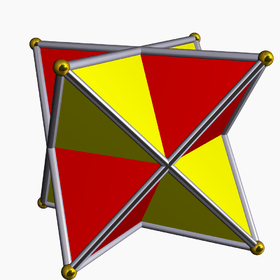Desmic system
In projective geometry, a desmic system is a set of three tetrahedra in 3-dimensional projective space, such that any two are desmic, (i.e. related such that each edge of one cuts a pair of opposite edges of the other). It was introduced by Stephanos (1879). The three tetrahedra of a desmic system are contained in a pencil of quartic surfaces. The name "desmic" comes from the Greek word δεσμός, meaning band or chain, referring to the pencil of quartics.


Every line that passes through two vertices of two tetrahedra in the system also passes through a vertex of the third tetrahedron. The 12 vertices of the desmic system and the 16 lines formed in this way are the points and lines of a Reye configuration.
Example
The three tetrahedra given by the equations
form a desmic system, contained in the pencil of quartics
for a + b + c = 0.
References
- Borwein, Peter B (1983), "The Desmic conjecture", Journal of Combinatorial Theory, Series A, 35 (1): 1–9, doi:10.1016/0097-3165(83)90022-5, MR 0704251.
- Hudson, R. W. H. T. (1990), Kummer's quartic surface, Cambridge Mathematical Library, Cambridge University Press, ISBN 978-0-521-39790-2, MR 1097176.
- Stephanos, Cyparissos (1879), "Sur les systèmes desmiques de trois tétraèdres", Bulletin des sciences mathématiques et astronomiques, Sér. 2, 3 (1): 424–456, JFM 11.0431.01.